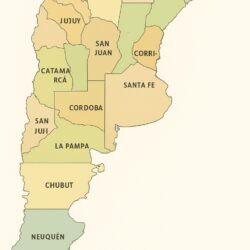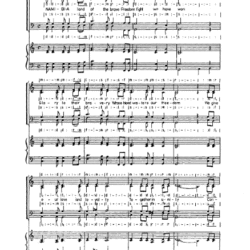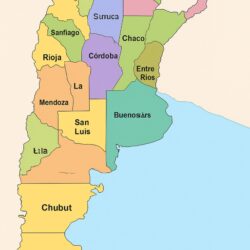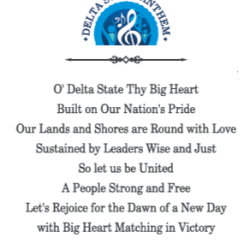Lyrics
Oh, hear ye mortals, the sacred cry:
Liberty, liberty, liberty!
Hear the noise of chains broken,
see noble Equality in its throne.
On the face of the Earth rises
a new and glorious Nation,
its brow crowned with laurels,
𝄆 and a Lion defeated at its feet, 𝄇
𝄆 its brow crowned with laurels,
and a Lion defeated at its feet. 𝄇
Chorus:
May eternal be the laurels,
𝄆 That we knew how to win 𝄇
Crowned in glory, let’s live
or let’s swear with glory to die!
𝄆 Or let’s swear with glory to die! 𝄇
II
The faces of the new champions
Mars himself seems to encourage
Greatness makes its nest in their chests:
at their march they make everything tremble.
The tombs of the Inca are shaken,
and the passion returns to their bones
which begins to renew, for their children,
𝄆 their Fatherland’s ancient splendour, 𝄇
𝄆 which begins to renew, for their children,
their Fatherland’s ancient splendour. 𝄇
Chorus
III
But mountans and walls are felt
echoing with horrible noise:
the whole country is disturbed by cries
of revenge, of war and uproar.
The envy within the fierce tyrants
spat its pestipherous bile;
their bloody standard they raise
𝄆 provoking the cruelest fight, 𝄇
𝄆 their bloody standard they raise
provoking the cruelest fight. 𝄇
Chorus
IV
Don’t you see them over Mexico and Quito
lunge forth with stubborn rage
and how cry, bathed in blood,
Potosí, Cochabamba and La Paz?
Don’t you see them over sad Caracas
sow grief and tears and death?
Don’t you see them devour like beasts
𝄆 every people that surrenders to them? 𝄇
𝄆 Don’t you see them devour like beasts
every people that surrenders to them? 𝄇
Chorus
V
It challenges you, Argentines,
the pride of the vile invader;
your fields he stomps on, counting
all the glorious victories he left behind.
But the brave men that swore, united,
their merry liberty to uphold,
these bloodthirsty tigers
𝄆 with strong chests they’ll know to face, 𝄇
𝄆 these bloodthirsty tigers
with strong chests they’ll know to face. 𝄇
Chorus
VI
The valiant Argentine to arms
runs burning with strength and valour.
The bugle of war, like thunder,
echoed in the fields of the South.
Buenos Ayres resists, at the front
of the peoples of the illustrious Union,
and with strong arms they tear apart
𝄆 the arrogant Iberian lion, 𝄇
𝄆 and with strong arms they tear apart
the arrogant Iberian lion. 𝄇
Chorus
VII
San José, San Lorenzo, Suipacha,
both Piedras, Salta and Tucumán,
La Colonia and the very walls
of the tyrant in the Banda Oriental.
Are eternal signboards that say:
here the Argentine arm triumphed,
here the fierce oppressor of the Fatherland
𝄆 bent his proud neck, 𝄇
𝄆 here the fierce oppressor of the Fatherland
bent his proud neck. 𝄇
Chorus
VIII
The Argentine warrior Victory
covered with her shining wings,
and dismayed at her sight the tyrant
with infamy took to flight.
His flags, his arms are surrendered
as trophies to Liberty,
and on wings of glory she raises the people,
𝄆 a throne worthy of their great majesty, 𝄇
𝄆 and on wings of glory she raises the people,
a throne worthy of their great majesty. 𝄇
Chorus
IX
From one pole to the other echoes
the resounding bugle of fame,
and of America, teaching its name,
it repeats: “Mortals, hear ye:
Now the United Provinces of the South
have opened their most worthy throne”.
And the free people of the world reply:
𝄆 “To the great Argentine people: cheers!” 𝄇
𝄆 And the free people of the world reply:
“To the great Argentine people: cheers!” 𝄇
Chorus

The Argentine National Anthem (Himno Nacional Argentino) is one of the earliest and most emblematic national songs in Latin America, adopted officially on May 11, 1813 during Argentina’s War of Independence. With lyrics by Vicente López y Planes and music by the Spanish-born composer Blas Parera, the anthem stands as a patriotic testament to Argentina’s fight for freedom against Spanish colonial rule and remains a powerful expression of national identity.
Origins and Early Development
Argentina’s journey toward its national anthem began after the May Revolution of 1810, which set in motion the path to independence. In the following years, revolutionary leaders sought to forge symbols that could unite the provinces and consolidate a sense of nationhood.
- In 1810, the first tentative anthems appeared, though they were not widely adopted.
- By 1812, the Assembly of Year XIII tasked López y Planes with writing the official lyrics.
- The music was composed shortly after by Parera, and the anthem premiered in May 1813 at the home of Mariquita Sánchez de Thompson, a leading salon hostess of Buenos Aires who played a vital role in Argentina’s cultural life.
This original composition, known as the “Patriotic March”, was far longer than the anthem sung today. Its verses contained fiery, militant language against Spanish rule, calling upon “mortals” to defend freedom and portraying the Spanish crown as an “arrogant Iberian lion.”
Structure and Evolution
The original anthem lasted 20 minutes when sung in full, with lengthy stanzas describing the revolution, battles, and ultimate liberation from Spain.
Over time, as Argentina’s relationship with Spain normalized, the strongly anti-Spanish content was considered diplomatically inappropriate. Gradual changes were introduced:
- 1900s Reform: The Argentine government formally shortened the anthem, officially codifying the version still used today.
- The modern rendition preserves:
- The first verse (the opening call to freedom: “Oíd, mortales, el grito sagrado: ¡Libertad! ¡Libertad! ¡Libertad!”).
- The last verse and the chorus, which emphasize unity and celebration of liberty.
- The explicitly anti-Spanish passages were omitted, allowing the anthem to focus on universal ideals of independence, freedom, and patriotism rather than hostility toward Spain.
As a result, the official anthem now runs about 3 minutes and 30 seconds, depending on arrangement.
Symbolism and Meaning
The anthem captures Argentina’s revolutionary fervor and desire for sovereignty.
- Freedom as the central theme: The repeated cry of “Liberty!” underscores the revolutionary spirit of the early 19th century.
- Unity of the people: The anthem addresses “mortals” collectively, emphasizing national solidarity beyond class or regional lines.
- Heroism and sacrifice: The original verses honored those who fought Spain, reflecting the struggles of the independence wars.
Even in its shortened form, the anthem remains a symbol of resilience, courage, and unity, resonating across generations.
Musical Character
Blas Parera’s score is deeply influenced by the European classical tradition, particularly Italian opera, which was popular in Buenos Aires at the time. Its dramatic orchestration and operatic flair suited the anthem’s original revolutionary spirit, designed to inspire both solemn reflection and national pride.
Performances vary:
- Military bands highlight its martial grandeur.
- Choir renditions emphasize solemn patriotism.
- In international events, shorter instrumental versions are often used for protocol.
Cultural and Historical Significance
- National Anthem Day: Every May 11, Argentina commemorates the adoption of its anthem (Día del Himno Nacional Argentino).
- Ceremonial use: The anthem is performed at schools, government events, sports competitions, and cultural festivals.
- Diaspora communities: Argentine expatriates worldwide treat the anthem as a link to homeland, often singing it at national holidays abroad.
Unlike many national anthems born later in the 19th or 20th centuries, Argentina’s anthem stands out as one of the oldest still in use, rooted directly in the era of Latin American independence.
The Himno Nacional Argentino reflects Argentina’s origins as a free nation. First sung in 1813 at the dawn of independence, it evolved from a fiery revolutionary hymn into a universal call to liberty. Today, with its soaring operatic melody and timeless cry for freedom, it endures as one of the most powerful patriotic symbols of Argentina’s national identity.
Every time it is performed — whether at a classroom ceremony in Buenos Aires, a soccer match abroad, or a state occasion — it reaffirms the values of independence, unity, and resilience that defined Argentina’s birth as a nation.
Perfect — here’s a side-by-side bilingual summary of the verses from the shortened, official Argentine National Anthem (the version codified in 1900 and still sung today). I’ll give you a faithful summary of each passage in both Spanish (original sense) and English (meaning) so you see how the anthem flows without needing the full copyrighted lyrics.
🇦🇷 Himno Nacional Argentino (Summary of Official Sung Verses)
1. Opening Verse
Spanish (summary)
“¡Oíd, mortales, el grito sagrado: libertad, libertad, libertad! Escuchad el ruido de rotas cadenas, mirad en el trono a la noble igualdad.”
English (meaning)
“Hear, mortals, the sacred cry: Freedom, freedom, freedom! Listen to the sound of broken chains, and see noble equality seated upon the throne.”
👉 This verse establishes the anthem’s central theme: liberation from tyranny and the triumph of freedom and equality.
2. Chorus
Spanish (summary)
“Sean eternos los laureles que supimos conseguir; coronados de gloria vivamos, o juremos con gloria morir.”
English (meaning)
“May the laurels we won be eternal; crowned with glory, let us live — or let us swear to die gloriously.”
👉 The chorus is a solemn pledge of patriotism: either to live with honor and independence or to sacrifice life for freedom.
3. Closing Verse
Spanish (summary)
“Del nuevo campeón los rostros se ven; al gran pueblo argentino ¡salud! Y los libres del mundo responden: al gran pueblo argentino, ¡salud!”
English (meaning)
“The faces of the new champion (the nation) are seen; to the great Argentine people, greetings! And the free peoples of the world respond: to the great Argentine people, greetings!”
👉 The anthem closes with Argentina proudly joining the community of free nations, its independence recognized beyond its borders.
Key Notes
- The original 1813 lyrics had additional stanzas filled with imagery of battle, Spanish tyranny, and South American revolution. These were removed in 1900.
- The official sung version today contains only the opening stanza, the chorus, and the closing stanza as outlined above.
- In practice, many public events perform just the chorus, making it even shorter.
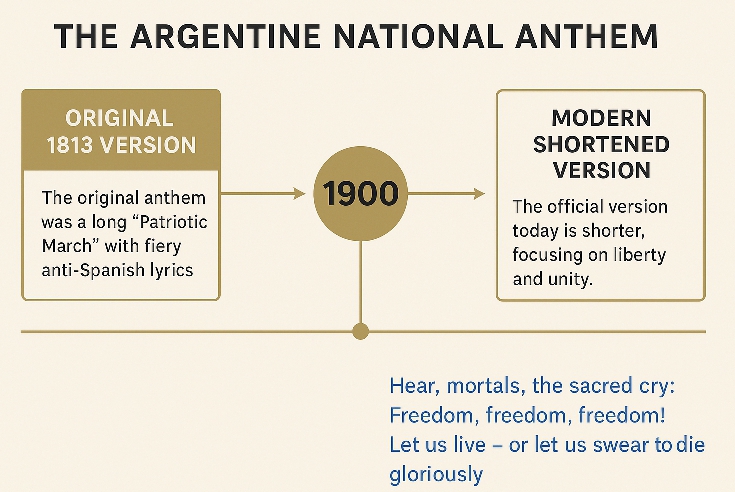
Structure of the Anthem
Original 1813 Version (Vicente López y Planes)
- Length: About 9 stanzas plus chorus, making performances last up to 20 minutes.
- Tone: Very fiery and explicitly anti-Spanish.
- Themes:
- Calls to arms against tyranny.
- Depictions of the “Iberian lion” (Spain) being torn apart.
- Evocation of freedom spreading through South America.
- Honor to revolutionary heroes and martyrs.
This original text reflected Argentina’s revolutionary fervor and the violent struggle against Spanish colonial power.
Modern Shortened Version (since 1900)
- Official Text: Only the first stanza, the chorus, and the last stanza are retained for performance.
- What was omitted: The highly anti-Spanish verses, once useful in wartime propaganda but later considered inappropriate as Argentina normalized relations with Spain.
Key Elements of Today’s Version
- Opening (first stanza):
- Begins with a direct call: “Hear, mortals, the sacred cry: Freedom! Freedom! Freedom!”
- Declares that freedom is the people’s great cry and that the throne of liberty has been established.
- Chorus:
- Invites the people to sing joyfully and celebrate their liberation.
- Expresses unity of the Argentine nation.
- Closing (final stanza):
- Emphasizes peace, glory, and continued vigilance to defend freedom.
- Reaffirms the permanence of independence.
Cultural Use of Lyrics
- Schools: Argentine children learn and sing the official shortened version.
- Ceremonies: Often only the chorus and fragments are sung in public events to save time.
- International Events: Typically, the anthem is performed instrumentally or in a brief vocal rendition.



